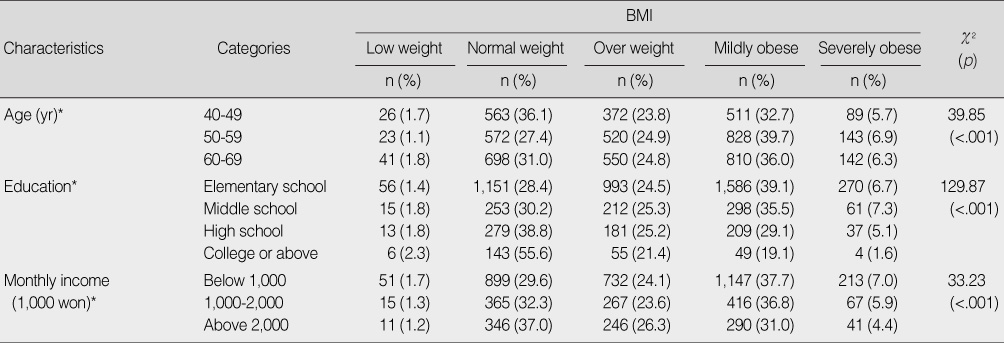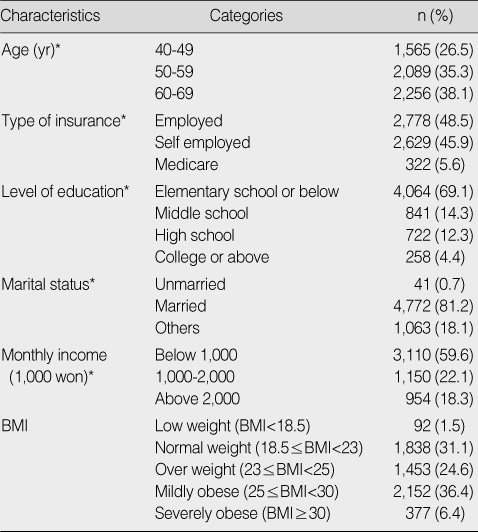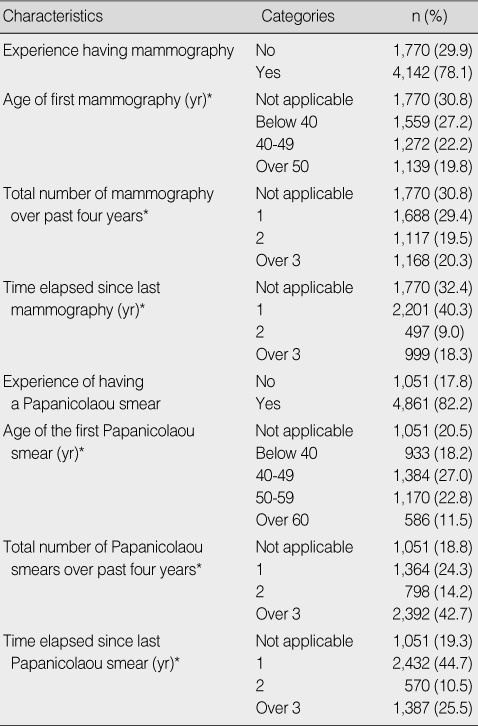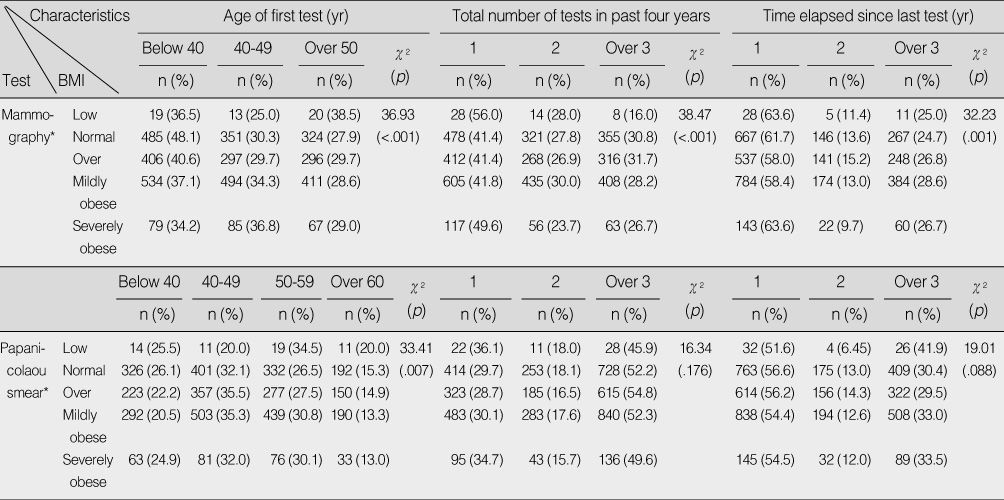Articles
- Page Path
- HOME > J Korean Acad Nurs > Volume 39(5); 2009 > Article
-
Original Article
- Women's Cancer Screening According to Body Mass Index in a Cohort of Rural Korean Women
- Bo Hwan Kim, Sang Baek Koh, Hea Kung Hur, Jong-Ku Park, So Mi Park
-
Journal of Korean Academy of Nursing 2009;39(5):641-650.
DOI: https://doi.org/10.4040/jkan.2009.39.5.641
Published online: October 31, 2009
1Post-doctoral Researcher, Department of Endocrine Internal Medicine, Wonju College of Medicine, Yonsei University, Korea.
2Associate Professor, Department of Preventive Medicine, Institute of Genomic Cohort, Wonju College of Medicine, Yonsei University, Korea.
3Professor, Department of Nursing, Wonju College of Medicine, Yonsei University, Korea.
4Professor, Department of Preventive Medicine, Institute of Genomic Cohort, Wonju College of Medicine, Yonsei University, Korea.
5Associate Professor, Department of Nursing, Institute of Genomic Cohort, Wonju College of Medicine, Yonsei University, Wonju, Korea.
- Address reprint requests to: Park, So Mi. Department of Nursing, Wonju College of Medicine, Yonsei University, 162 Ilsan-dong, Wonju 220-701, Korea. Tel: 82-33-741-0388, Fax: 82-33-743-9490, somi@yonsei.ac.kr
Copyright © 2009 Korean Society of Nursing Science
Abstract
-
Purpose
- This study was done to examine the difference in cancer screening with mammography and Papanicolaou smear according to Body Mass Index (BMI).
-
Methods
- The participants in this study were 5,912 women ages 40 to 69 yr, selected from the Korean Genomic Regional Cohort in Kangwon province. Mammography and Papanicolaou smear were assessed by questionnaire and body weight (kg) and height (m) measured to calculate BMI.
-
Results
- The distribution of BMI was as follows: low weight (1.5%), normal weight (31.1%), over weight (24.6%), mildly obese (36.4%) and severely obese (6.3%). After adjusting for age, education and monthly income, compared with normal weight women, overweight women (odds ratio [OR]=1.283, 95% confidence interval [CI]=1.089-1.513) and mildly obese women (OR=1.214, 95% CI=1.048-1.406) were less likely to have had mammography. In contrast to mammography, cancer screening with Papanicolaou smear was not significantly different by BMI.
-
Conclusion
- Obese women in rural areas are less likely to screen for breast cancer by using mammography than non obese women. To ensure regular screening for breast cancer, health care providers need to give scrupulous care to obese women and remove barriers originated from obesity. Also, educational and clinical implications are considered to increase the Papanicolaou smear rate.
This work was supported by the Korea Research Foundation Grant funded by the Korea Goverment (KRF-2008-8-1517).
- 1. Amy NK, Aalborg A, Lyons P, Keranen L. Barriers to routine gynecological cancer screening for White and AfricanAmerican obese women. International Journal of Obesity. 2006;30:147–155.ArticlePubMedPDF
- 2. Calle EE, Rodriguez C, Walker-Thurmond K, Thun MJ. Overweight, obesity, and mortality from cancer in a prospectively studied cohort of U.S. adults. New England Journal of Medicine. 2003;348:1625–1638.ArticlePubMed
- 3. Calle EE, Thun JJ. Obesity and cancer. Oncogene. 2004;23:6365–6378.ArticlePubMedPDF
- 4. Carroll KK. Obesity as a risk factor for certain types of cancer. Lipids. 1998;33:1055–1057.ArticlePubMed
- 5. Chlebowski RT, Aiello E, McTiernan A. Weight loss in breast cancer patient management. Journal of Clinical Oncology. 2002;20:1128–1143.ArticlePubMed
- 6. Cui Y, Whiteman MK, Langenberg P, Sexton M, Tkaczuk KH, Flaws JA, et al. Can obesity explain the racial difference in stage of breast cancer at diagnosis between black and white women? Journal of Women's Health & Gender-Based Medicine. 2002;1:527–536.
- 7. Eun Y, Song MS, Gu MO. Barriers to health behaviors in male and female elderly people in Korea. Journal of Korean Academy of Nursing. 2008;32:332–343.
- 8. Fernante JM, Chen PH, Crabtree BF, Wartenberg D. Cancer screening in women: Body mass index and adherence to physician recommendation. American Journal of Preventive Medicine. 2007;32:525–531.ArticlePubMedPMC
- 9. Fletcher SW, Black W, Harris R, Rimer BK, Shapiro S. Report of the international workshop on screening forbreast cancer. Journal of National Cancer Institution. 1993;85:1664–1656.
- 10. Fontaine KR, Heo M, Allison DB. Body weight and cancer screening among women. Journal of Women's Health & Gender-Based Medicine. 2001;10:463–470.Article
- 11. Hart DJ, Spector TD. The relationship of obesity, fat distribution and osteoarthritis in women in the general population:The Chingford study. Journal of Rheumatology. 1993;20:331–335.PubMed
- 12. Kim DS, Jun MH. Body mass percentage and natural killer cell activity of breast and rectal cancer patients after diagnosis but before treatment. Journal of Korean Academy of Nursing. 2008;32:321–331.
- 13. Korea Centers for Disease Control and Prevention. The 3rd National Health and Nutrition Survey Results of Korea: Screening parts. 2007;Seoul, Author.
- 14. The statistics of public health (2007): The 4th national health and nutrition survey of Korea. Ministry for Health, Welfare and Family Affairs & Korea Centers for Disease Control and Prevention. 2008;12 31 Retrieved April 10, 2009. from http://knhanes.cdc.go.kr pdf.
- 15. Cancer control 2015: The 2nd cancer control planning for 10 years. Ministry of Health and Welfare. 2006;04 25 Retrieved April 10, 2009. from http://www.mw.go.kr/front/jb/sjb030301vw.jsp?PAR_MENU_ID=03&MENU_ID=03030301&BOARD_ID=1003&BOARD_FLAG=01&CONT_SEQ=37866&page=1.
- 16. Mitchell RS, Padwal RS, Chunk AW, Klarenbach SW. Cancer screening among the overweight and obese in Canada. American Journal of Preventive Medicine. 2008;35:127–132.ArticlePubMed
- 17. Morimoto LM, White E, Chen Z, Chelebowski RT, Hays J. Obesity, body size, and risk of postmenopausal breast cancer: The women's health initiative. Cancer Cause Control. 2002;13:741–751.
- 18. What is the national cancer early screening? National Cancer Information Center. 2009;Retrieved April 9, 2009. from https://ncs.ncc.re.kr/ncsapps/ncs_info/ncs_info.jsp.
- 19. Ou SW, Yoo TW, Huh BY, Ahn YO, Yun YH, Shin SA. Search for criterion of obesity through analysis of morbidity and mortality in Korean obesity. The Korean Journal of Obesity. 2002;11:304.
- 20. Park SM, Chang SB, Chung CW. Context of barriers to Pap testing in Korean women. Applied Nursing Research. 2006;19:177–181.ArticlePubMed
- 21. Puhl R, Brownell KD. Bias, discrimination, and obesity. Obesity Research. 2001;9:788–805.ArticlePubMed
- 22. Sanson RA, Sanson LA, Weiderman MW. The relationship between obesity and medical utilization among women in a primary care setting. International Journal of Eating Disorder. 1998;23:161–167.Article
- 23. Schindler AE. Obesity and cancer risk in women. Archives Gynecology Obstetrics. 1997;261:21–25.ArticlePDF
- 24. Slevan MS, Winkinson AV, Chamberlain R, Bondy ML. Social and dietary changes associated with obesity and breast cancer risk. Journal of Health Management. 2004;6:103–114.ArticlePDF
- 25. Sohn A, Jin K. The difference of socio-demographic variables and health-related behaviors. Journal of Korean Society for Health Education and Promotion. 2008;25(4):1–11.
- 26. Solomon D. Chapter 14: Role of triage testing in cervical cancer screening. Journal of National Cancer Institute Monographs,. 2003;31:97–101.
- 27. Stephenson GD, Rose DP. Breast cancer and obesity: An update. Nutrition and Cancer. 2003;45:1–16.ArticlePubMed
- 28. Wee CC, McCarthy ME, Davis RB, Phillips RS. Screening for cervical and breast cancer: Is obesity an unrecognized barrier to preventive care? Annals of Internal Medicine. 2000;132:697–704.ArticlePubMed
REFERENCES

Figure & Data
REFERENCES
Citations

- Determinants of breast cancer screening uptake in Kurdishwomen of Iran
Nayyereh Aminisani, Rojin Fattahpor, Saeed Dastgiri, Mohamad Asghari Jafarabadi, Hamid Allahverdipour
Health Promotion Perspectives.2016; 6(1): 42. CrossRef - Lifestyle and health-related predictors of cervical cancer screening attendance in a Swiss population-based study
Aline Richard, Sabine Rohrmann, Seraina M. Schmid, Brigitte Frey Tirri, Dorothy J. Huang, Uwe Güth, Monika Eichholzer
Cancer Epidemiology.2015; 39(6): 870. CrossRef - Evaluation of Diet Quality according to Self-Rated Health Status of Korean Middle-Aged Women -Based on 2008~2009 Korean National Health and Nutrition Examination Survey-
Hye-Jin Lee, Kyung-Hea Lee
Journal of the Korean Society of Food Science and Nutrition.2013; 42(9): 1395. CrossRef - Factors Associated with Mammography Adherence among Married Chinese Women in Yanbian, China
Moonhee Gang, Jong Im Kim, Kyong Ok Oh, Chun Yu Li, Youngshin Song
Asian Pacific Journal of Cancer Prevention.2013; 14(12): 7207. CrossRef - Effects of Tailored Message Education About Breast Cancer Risk Appraisal for Obese Korean Women
SoMi Park, ChaeWeon Chung, Barbara B. Cochrane
Oncology Nursing Forum.2013; 40(6): E382. CrossRef - Comparison of Breast Cancer Risk Estimations, Risk Perception, and Screening Behaviors in Obese Rural Korean Women
SoMi Park, Barbara B. Cochrane, Sang Baek Koh, ChaeWeon Chung
Oncology Nursing Forum.2011; 38(6): E394. CrossRef - Use of mammography, Pap test and prostate examination by body mass index during the developmental period of cancer screening in Estonia
M. Tekkel, T. Veideman, M. Rahu
Public Health.2011; 125(10): 697. CrossRef
Characteristics of Participants (N=5,912)
*Exclude missing data and not applicable cases.
BMI=body mass index.
Distribution of the Characteristics in Women's Cancer Screening Behaviors (N=5,912)
*Exclude missing data and not applicable cases.
Comparison of BMI categories according to Demographic Socioeconomic Characteristics (N=5,912)
*Exclude missing data and not applicable cases.
BMI=body mass index.
Comparison of Women's Cancer Screening Behaviors among BMI groups (N=5,912)
*Exclude missing data and not applicable cases.
BMI=body mass index.
Women's Cancer Screening according to Levels of BMI: Logistic Regression Results (N=5,912)
*p<.05; **p<.01. †Adjusted variables: age, education and economic level.
BMI=body mass index; OR=odds ratio; CI=confidence interval.
*Exclude missing data and not applicable cases. BMI=body mass index.
*Exclude missing data and not applicable cases.
*Exclude missing data and not applicable cases. BMI=body mass index.
*Exclude missing data and not applicable cases. BMI=body mass index.
* BMI=body mass index; OR=odds ratio; CI=confidence interval.
 KSNS
KSNS
 E-SUBMISSION
E-SUBMISSION




 Cite
Cite

